-
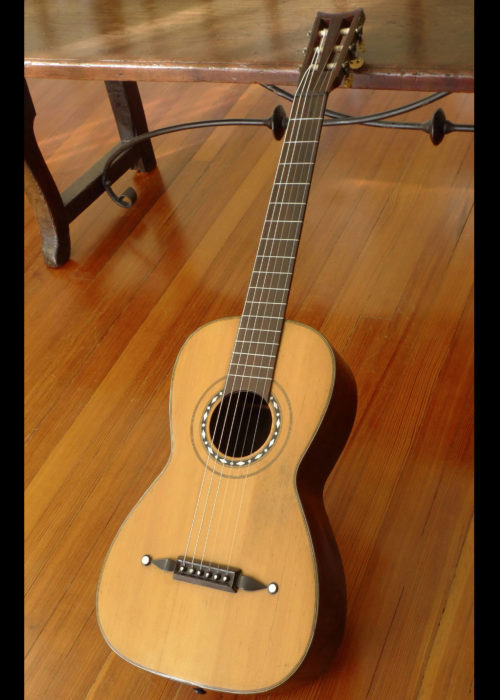 More rare than a Panormo guitar, this original, wonderfully preserved and sonorous guitar is from the London-based J. Guiot, circa 1846– and it’s a cousin if not a sibling of a Panormo, in style, appointments, and provenance. The headstock and neck volute of this instrument, as well as the bridge, exactly match that of two known Guiot guitars of the period (see links below). It’s possible that this guitar was made in the workshop of Panormo by Guiot while he worked there, and it is in fact Panormo in style, exactly– but likely it’s one of the very rare-on-the-market Guiot guitars made after Guiot established an independent workshop in the 1840’s. Either way, we guarantee it as a Guiot, and the value of Guiots– being very rare– are in line with Panormos. This guitar is in remarkable original condition, with none of the kinds of damage, major repairs, or structural issues found on nearly all surviving instruments of the period. And even more importantly, it plays wonderfully as well. We simply adjusted the nut a bit, and leveled the original frets, and it plays like it was recently made– but with a sound that only an 1840’s, London-made Spanish style guitar can produce. The intonation is great. Action is fine– not too high. Listen to the sound/video clip of this guitar being played, by clicking here. (Note: the video is labeled “Panormo” because the instrument was thought to be a Panormo when the recording was made. The guitar being played on the video is indeed this instrument). The guitar has a couple of repaired back cracks, and one well repaired top crack– amazingly little for a guitar this age. The features of this instrument: All original finish Spruce top Brazilian Rosewood back and sides Original Baker Tuners Original pin bridge, that has never been off the guitar Original frets Fan braced, 5 fan braces Scale length: 25 inches (63.5 cm) Lower bout: 11 3/8 inch (29.3 cm) Upper bout: 8 ¾ inches String spacing at bridge: 2 ½ inches Nut: 47 cm String spacing at nut: 1 ¾ inches Depth of sides (bottom): 4 inches (10cm) Depth of sides (top): 3 ½ Body length: 17 ¾ J. Guiot and A. Guiot were some of the luthiers who left France between 1830 and 1850, to work in London– and like Panormo, the Guiots made guitars in the Spanish style. Panormo had adopted a more Spanish style of guitar building in large part due to the urging of Fernando Sor– and that style that would soon overtake the French style, and eventually dominate in the new world as well (i.e. CF Martin’s adoption of the Spanish style of guitar making circa 1844 onward). The well known American composer and performer Madame Sydney Pratten was an ardent proponent of– and player of– the Guiot guitars in the mid-19th century. Reference: two Guiot instruments with the exact headstock and neck volute, and bridge (and also fret markers on 5, 7, and 9 position on the 1846 instrument): • Terz guitar, made by Guiot, Panormo model, London, made 1846– click here to view • J. Guiot, Panormo school guitar, made 1844 – click here to view. The instrument is in a modern hard shell case. Price: $6950.
More rare than a Panormo guitar, this original, wonderfully preserved and sonorous guitar is from the London-based J. Guiot, circa 1846– and it’s a cousin if not a sibling of a Panormo, in style, appointments, and provenance. The headstock and neck volute of this instrument, as well as the bridge, exactly match that of two known Guiot guitars of the period (see links below). It’s possible that this guitar was made in the workshop of Panormo by Guiot while he worked there, and it is in fact Panormo in style, exactly– but likely it’s one of the very rare-on-the-market Guiot guitars made after Guiot established an independent workshop in the 1840’s. Either way, we guarantee it as a Guiot, and the value of Guiots– being very rare– are in line with Panormos. This guitar is in remarkable original condition, with none of the kinds of damage, major repairs, or structural issues found on nearly all surviving instruments of the period. And even more importantly, it plays wonderfully as well. We simply adjusted the nut a bit, and leveled the original frets, and it plays like it was recently made– but with a sound that only an 1840’s, London-made Spanish style guitar can produce. The intonation is great. Action is fine– not too high. Listen to the sound/video clip of this guitar being played, by clicking here. (Note: the video is labeled “Panormo” because the instrument was thought to be a Panormo when the recording was made. The guitar being played on the video is indeed this instrument). The guitar has a couple of repaired back cracks, and one well repaired top crack– amazingly little for a guitar this age. The features of this instrument: All original finish Spruce top Brazilian Rosewood back and sides Original Baker Tuners Original pin bridge, that has never been off the guitar Original frets Fan braced, 5 fan braces Scale length: 25 inches (63.5 cm) Lower bout: 11 3/8 inch (29.3 cm) Upper bout: 8 ¾ inches String spacing at bridge: 2 ½ inches Nut: 47 cm String spacing at nut: 1 ¾ inches Depth of sides (bottom): 4 inches (10cm) Depth of sides (top): 3 ½ Body length: 17 ¾ J. Guiot and A. Guiot were some of the luthiers who left France between 1830 and 1850, to work in London– and like Panormo, the Guiots made guitars in the Spanish style. Panormo had adopted a more Spanish style of guitar building in large part due to the urging of Fernando Sor– and that style that would soon overtake the French style, and eventually dominate in the new world as well (i.e. CF Martin’s adoption of the Spanish style of guitar making circa 1844 onward). The well known American composer and performer Madame Sydney Pratten was an ardent proponent of– and player of– the Guiot guitars in the mid-19th century. Reference: two Guiot instruments with the exact headstock and neck volute, and bridge (and also fret markers on 5, 7, and 9 position on the 1846 instrument): • Terz guitar, made by Guiot, Panormo model, London, made 1846– click here to view • J. Guiot, Panormo school guitar, made 1844 – click here to view. The instrument is in a modern hard shell case. Price: $6950. -
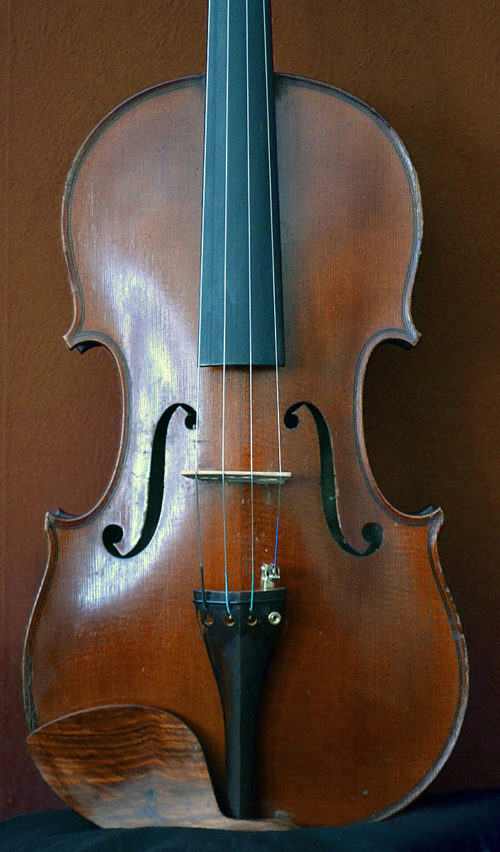 Full size, Charles Fetique violin (French, early 20th century – circa 1930), with original label inside. This is a rich, sonorous instrument. A deep, round tone, that – like all good violins – does not make you work overly hard to attain. It has a darker, lush, round tone that professional players love – and great projection. We recently A-B'd this instrument against $5k+ violins in the area, and there was no comparison, this instrument was louder, more full, more round and full in the bass notes, and all around a stellar performer. This violin would be a great student violin upgrade – for that aspiring violinist who is ready to graduate to, and enjoy, a better instrument than what's typically available in the $4-5K range, at a very attractive price. And, the buyer will have the confidence of both a Letter of Expertise, and a professional appraisal: • Certificate: Jean-Jacques Rampal, Paris, 2014. (This is the letter of expertise, on this violin, from one of the top experts on French Violins, in Paris, France). And: • Written, professional appraisal of the violin, done from personal inspection, from one of the top violin shops/experts in Texas (Jay R. Rury Violins, Dallas), with a valuation of $3,500.00 Both the above documents will be included with the sale. The violin is in excellent condition. There are no sound post, or bass bar cracks. It was professionally set up to play, by Blackerby Violin in Austin. In a modern Tonerelli case. Price: $3250.
Full size, Charles Fetique violin (French, early 20th century – circa 1930), with original label inside. This is a rich, sonorous instrument. A deep, round tone, that – like all good violins – does not make you work overly hard to attain. It has a darker, lush, round tone that professional players love – and great projection. We recently A-B'd this instrument against $5k+ violins in the area, and there was no comparison, this instrument was louder, more full, more round and full in the bass notes, and all around a stellar performer. This violin would be a great student violin upgrade – for that aspiring violinist who is ready to graduate to, and enjoy, a better instrument than what's typically available in the $4-5K range, at a very attractive price. And, the buyer will have the confidence of both a Letter of Expertise, and a professional appraisal: • Certificate: Jean-Jacques Rampal, Paris, 2014. (This is the letter of expertise, on this violin, from one of the top experts on French Violins, in Paris, France). And: • Written, professional appraisal of the violin, done from personal inspection, from one of the top violin shops/experts in Texas (Jay R. Rury Violins, Dallas), with a valuation of $3,500.00 Both the above documents will be included with the sale. The violin is in excellent condition. There are no sound post, or bass bar cracks. It was professionally set up to play, by Blackerby Violin in Austin. In a modern Tonerelli case. Price: $3250. -
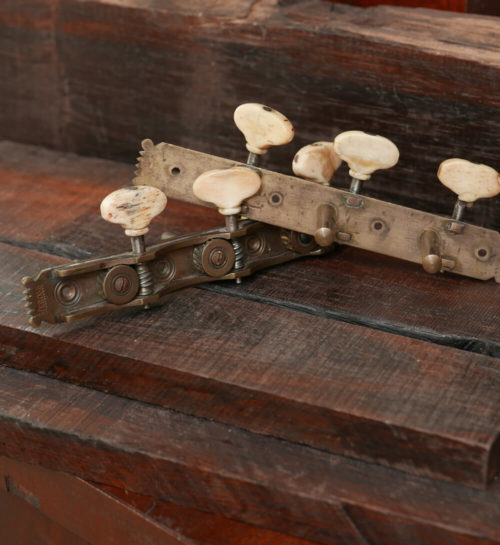 Even more rare, early Jerome’s, made in France. Circa 1840 -1850. Unusual design. Missing one post/worm gear. Damage to one worm gear bracket. Price: $795.
Even more rare, early Jerome’s, made in France. Circa 1840 -1850. Unusual design. Missing one post/worm gear. Damage to one worm gear bracket. Price: $795. -
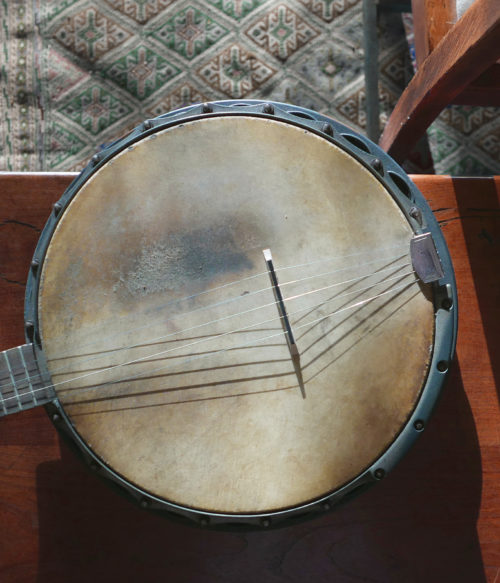 This Banjo has a unique tone, that only comes from a Gretsch Die-cast metal shell/flange construction, prewar banjo. But it’s rare to see these banjos in anything other than tenor. This one is a rare, original 5 string configuration, and has a nice “Gretsch growl” (a term that some drummers use to describe Gretsch drums). Wonderful, dark tone, with bell-like high notes. And with a bit of sustain that is reminiscent of a prewar Dobro guitar. Growl, plus sustain, and ringing highs – only from a Gretsch prewar banjo. Pearloid heastock overlay. 11 inch head. 26 inch scale length. 22-fret Brazilian rosewood fingerboard, with dot markers. Walnut neck, and resonator. Top tension head adjustment with 20 lugs. Original calf skin head. Price: $750.
This Banjo has a unique tone, that only comes from a Gretsch Die-cast metal shell/flange construction, prewar banjo. But it’s rare to see these banjos in anything other than tenor. This one is a rare, original 5 string configuration, and has a nice “Gretsch growl” (a term that some drummers use to describe Gretsch drums). Wonderful, dark tone, with bell-like high notes. And with a bit of sustain that is reminiscent of a prewar Dobro guitar. Growl, plus sustain, and ringing highs – only from a Gretsch prewar banjo. Pearloid heastock overlay. 11 inch head. 26 inch scale length. 22-fret Brazilian rosewood fingerboard, with dot markers. Walnut neck, and resonator. Top tension head adjustment with 20 lugs. Original calf skin head. Price: $750. -
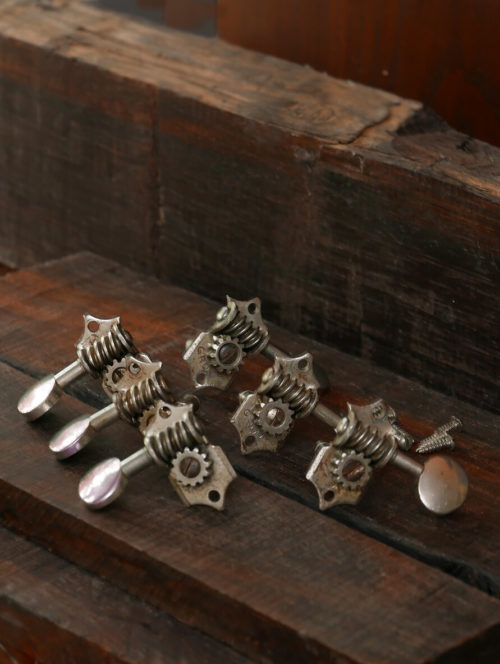 6:1 ratio pre war Grovers, mid-1930's. As used on Martin pre-war dreadoaught guitars. Oval buttons, bevelled edges on the baseplate. Just one button has some missing chrome on one side (see photos). With bushings, and mounting screws. No bent shafts. Good working condition. Price: $795.
6:1 ratio pre war Grovers, mid-1930's. As used on Martin pre-war dreadoaught guitars. Oval buttons, bevelled edges on the baseplate. Just one button has some missing chrome on one side (see photos). With bushings, and mounting screws. No bent shafts. Good working condition. Price: $795. -
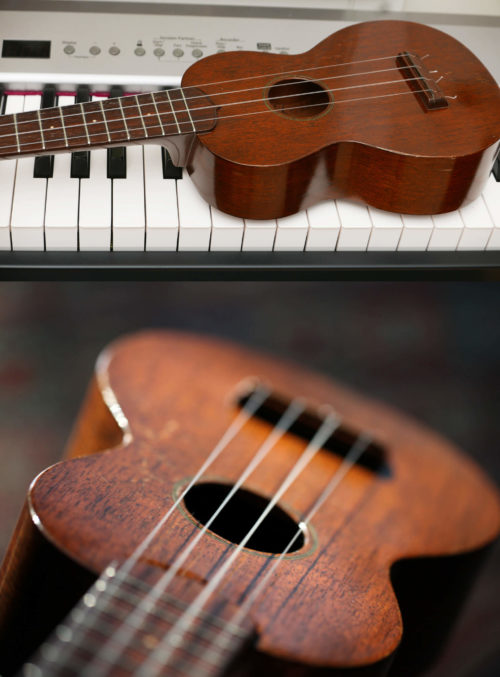 This is great example of Martin’s post war, 1950’s style 0 Ukulele. It has a few nicks and dings, but it’s 100% crack free. And it’s in its original case. It was made between 1957 and 1960 (as indicated by the tuners, and the lack of the “Made in U.S.A.”). Price: $995.
This is great example of Martin’s post war, 1950’s style 0 Ukulele. It has a few nicks and dings, but it’s 100% crack free. And it’s in its original case. It was made between 1957 and 1960 (as indicated by the tuners, and the lack of the “Made in U.S.A.”). Price: $995. -
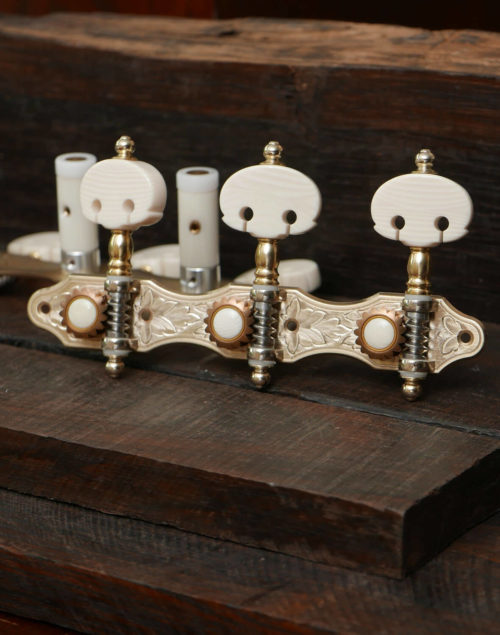 Alessi, Hauser style machine head tuners. More rare, deep silver plating. Hand made in Italy. Engraved with high detail. These are new, old stock. Made circa 2009, they have never been used or mounted on a guitar, and they come with the original mounting screws, and in their original wood presentation case. Synthetic ivory kidney shaped buttons (rare style). 35mm on center. Perfect, unused condition. Price: $895.
Alessi, Hauser style machine head tuners. More rare, deep silver plating. Hand made in Italy. Engraved with high detail. These are new, old stock. Made circa 2009, they have never been used or mounted on a guitar, and they come with the original mounting screws, and in their original wood presentation case. Synthetic ivory kidney shaped buttons (rare style). 35mm on center. Perfect, unused condition. Price: $895. -
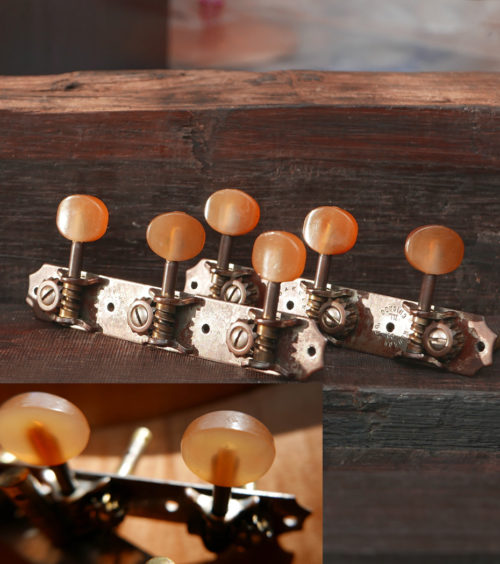 Pre-war Kluson tuners from the 1930's. Amber buttons. These are rare tuners that came on some of the nice Gibsons of the era, such as a few Gibson J35's. Good working condition. Price: $295. – on Hold
Pre-war Kluson tuners from the 1930's. Amber buttons. These are rare tuners that came on some of the nice Gibsons of the era, such as a few Gibson J35's. Good working condition. Price: $295. – on Hold -
Out of stock
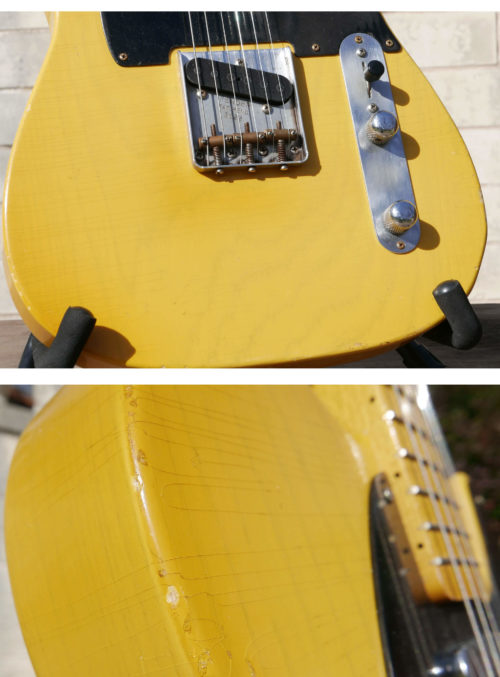 This could be the best blackguard telecaster tribute ever. An homage to the great early 50’s telecaster. But it only gets accolades if it’s a great player. This one is a great player–its light weight (same weight range as on original early 50s telecaster), pickups, setup, and attention to detail make for a great sounding tele. A joy to play. There appear to be a few original 1952/1953 parts on this guitar– but this guitar is being offered strictly as a reproduction/tribute. And it’s a tribute, in its way, to the art of the (great) copy– and on that note, it comes with Nacho Baños’ great book, The Blackguard book (out of print and a $300-400 value in itself), with matching serial number on the cover of the book. (Click here for a story on Baños.) So the purchaser can follow along the narrative of some of the great original early Blackguards in the book–and how to identify original early 50’s Telecaster, Nocaster, and Esquire elements and parts– while having fun with this intriguing tribute guitar. • The bridge, a good reproduction of unknown origin. The photos tell the story. (Original early 50’s brass saddles?). Reproduction tuners. • The pickguard looks convincing, but we're calling it a reproduction. • Seymour Duncan Antiquity pickups. • The pots, and the pickup switch, appear to be original 1952 or 1953 Fender parts (but not with original solder joints etc). • The control plate appears to be an original 1952/1953 Fender plate. Tone, volume knobs are (good) reproductions. • Neck is from Mark Jenny, stamped on heel as official Fender “Licensed” neck. Medium C profile. Great feel– not baseball bat, and not too thin. • Weight, with strings: 6.625 lbs. This is in the same weight range as original early 50s telecasters. Compare to the weight of mediocre telecaster “reissues” on the market today, all of which weigh much more. • The body is by Mark Jenny. We waited patiently for over a year until the right Jenny body became available, to complete this instrument in the best way possible and to remove from the market the (nice light weight) reproduction body that was in place when we acquired the guitar that had a non-authentic 1952 date and signature in the neck pocket. The right thing to do– and the Mark Jenny body in place now has crazing and other elements characteristic to the early blackguard look, weight, wear, and feel. • Set up perfectly, and ready to play. Sold as a reproduction/tribute guitar only, together with the Nacho Baños The Blackguard book (book in as-new condition in original box) that will school the new owner on how to evaluate the fine, fully pedigreed, great Blackguards of the early 50’s. Price: $5950.
This could be the best blackguard telecaster tribute ever. An homage to the great early 50’s telecaster. But it only gets accolades if it’s a great player. This one is a great player–its light weight (same weight range as on original early 50s telecaster), pickups, setup, and attention to detail make for a great sounding tele. A joy to play. There appear to be a few original 1952/1953 parts on this guitar– but this guitar is being offered strictly as a reproduction/tribute. And it’s a tribute, in its way, to the art of the (great) copy– and on that note, it comes with Nacho Baños’ great book, The Blackguard book (out of print and a $300-400 value in itself), with matching serial number on the cover of the book. (Click here for a story on Baños.) So the purchaser can follow along the narrative of some of the great original early Blackguards in the book–and how to identify original early 50’s Telecaster, Nocaster, and Esquire elements and parts– while having fun with this intriguing tribute guitar. • The bridge, a good reproduction of unknown origin. The photos tell the story. (Original early 50’s brass saddles?). Reproduction tuners. • The pickguard looks convincing, but we're calling it a reproduction. • Seymour Duncan Antiquity pickups. • The pots, and the pickup switch, appear to be original 1952 or 1953 Fender parts (but not with original solder joints etc). • The control plate appears to be an original 1952/1953 Fender plate. Tone, volume knobs are (good) reproductions. • Neck is from Mark Jenny, stamped on heel as official Fender “Licensed” neck. Medium C profile. Great feel– not baseball bat, and not too thin. • Weight, with strings: 6.625 lbs. This is in the same weight range as original early 50s telecasters. Compare to the weight of mediocre telecaster “reissues” on the market today, all of which weigh much more. • The body is by Mark Jenny. We waited patiently for over a year until the right Jenny body became available, to complete this instrument in the best way possible and to remove from the market the (nice light weight) reproduction body that was in place when we acquired the guitar that had a non-authentic 1952 date and signature in the neck pocket. The right thing to do– and the Mark Jenny body in place now has crazing and other elements characteristic to the early blackguard look, weight, wear, and feel. • Set up perfectly, and ready to play. Sold as a reproduction/tribute guitar only, together with the Nacho Baños The Blackguard book (book in as-new condition in original box) that will school the new owner on how to evaluate the fine, fully pedigreed, great Blackguards of the early 50’s. Price: $5950. -
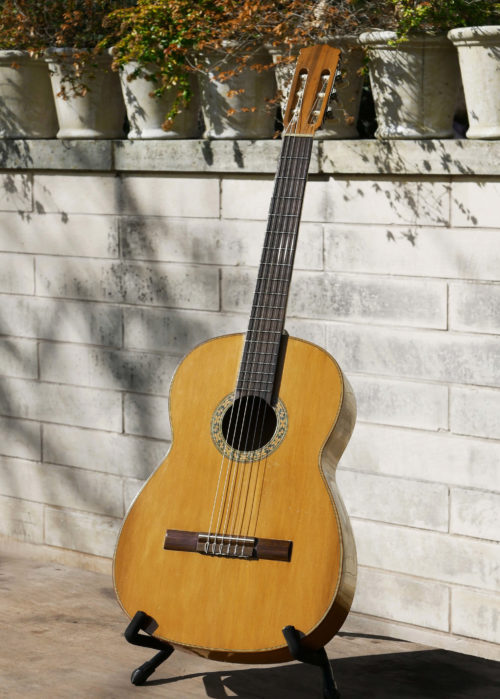 Another instrument from Enos Hernandez of Mexico, one of the best luthiers to ever live in work in Mexico, circa 1970’s. This one is a flamenco Blanca, with the classic cypress back and sides. Like the other Enos Hernandez we have, this one also has a cedar top. The instrument is super light weight, as a Flamenco Blanca should be, and it’s bright and percussive and raspy as a good Blanca should be. There is a scratch (not a crack) on back of guitar (see photo). There are dot position markers – original to the guitar, i.e. not added later – on top edge of fretboard (frets 3,5,7,9 – see photo). Scale length: 660mm Available January 2018 Price: $2950
Another instrument from Enos Hernandez of Mexico, one of the best luthiers to ever live in work in Mexico, circa 1970’s. This one is a flamenco Blanca, with the classic cypress back and sides. Like the other Enos Hernandez we have, this one also has a cedar top. The instrument is super light weight, as a Flamenco Blanca should be, and it’s bright and percussive and raspy as a good Blanca should be. There is a scratch (not a crack) on back of guitar (see photo). There are dot position markers – original to the guitar, i.e. not added later – on top edge of fretboard (frets 3,5,7,9 – see photo). Scale length: 660mm Available January 2018 Price: $2950 -
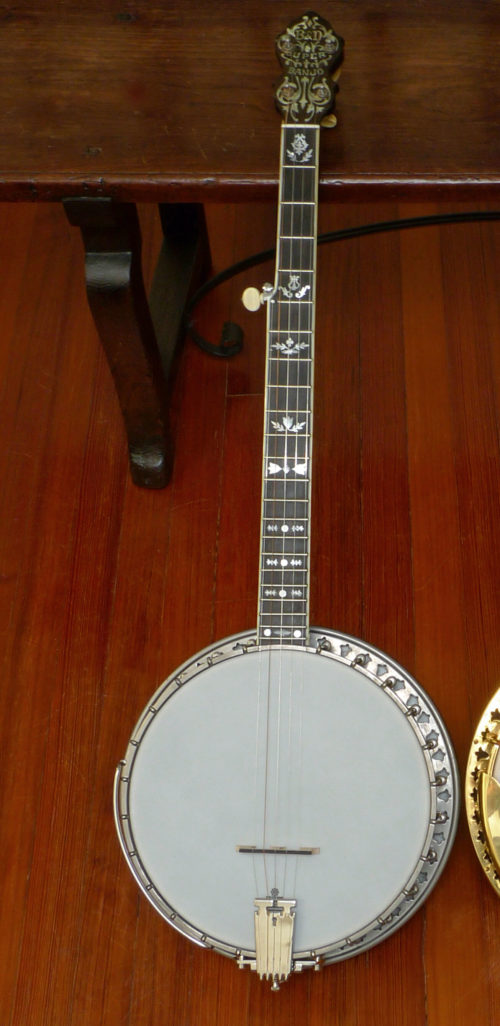 This is a superb sounding 5 string banjo. Original nickel plating. • Bacon & Day Super, 5-string Banjo (Style A) Serial number: 25892 (early 1928) • Resonator, stamped on inside (in nickel-laminated maple): Bacon Banjo Co., Inc. Groton, CT. U.S.A. Dec. 20th, 1927 • Conversion, 5 string neck (original neck was probably a tenor or plectrum); Presumably, this neck is newer than the banjo– yet the advanced MOP fret markers are as found on the earliest versions of B&D Super banjos. We assume this neck was built by one of the best U.S. “conversion” builders – with a re-use of the original MOP inlay at the peghead plus the dowel stick. Maple neck, with steel reinforcing rod. Fretboard is beautiful jet-black ebony; multi-layer neck bindings. Fretboard is a very comfortable 1 3/8 inches wide at the nut, 1 7/8 wide where fretboard meets body. • Nickel plated • 22 frets • Scale length: 27 inches • Extended Maple resonator– nickel laminated on inside • Original flat Tulip-hole flange (not the “add-on” round-hole resonator of earlier years). • Original, top of the line Type III Silver Bell tone ring (No Hole tone ring) original to the instrument (this is the most sought-after, advanced Silver Bell tone ring, introduced early 1927). • Original 2 band Grover geared tuning pegs • Fults tailpiece, and included a variety of Fults tone pins. Bob Fults made the best tailpieces available. And his tone pins let you tweak the tone of your banjo. There are several interchangeable Fults pins included here– ivory, ebony, lead, sterling silver, brass, and copper. Plus a “tone lock”. (Bob Fults recently retired, and these highly sought after Fults tailpieces and pins are no longer available.) In its original hard shell Lifton case. $3750.
This is a superb sounding 5 string banjo. Original nickel plating. • Bacon & Day Super, 5-string Banjo (Style A) Serial number: 25892 (early 1928) • Resonator, stamped on inside (in nickel-laminated maple): Bacon Banjo Co., Inc. Groton, CT. U.S.A. Dec. 20th, 1927 • Conversion, 5 string neck (original neck was probably a tenor or plectrum); Presumably, this neck is newer than the banjo– yet the advanced MOP fret markers are as found on the earliest versions of B&D Super banjos. We assume this neck was built by one of the best U.S. “conversion” builders – with a re-use of the original MOP inlay at the peghead plus the dowel stick. Maple neck, with steel reinforcing rod. Fretboard is beautiful jet-black ebony; multi-layer neck bindings. Fretboard is a very comfortable 1 3/8 inches wide at the nut, 1 7/8 wide where fretboard meets body. • Nickel plated • 22 frets • Scale length: 27 inches • Extended Maple resonator– nickel laminated on inside • Original flat Tulip-hole flange (not the “add-on” round-hole resonator of earlier years). • Original, top of the line Type III Silver Bell tone ring (No Hole tone ring) original to the instrument (this is the most sought-after, advanced Silver Bell tone ring, introduced early 1927). • Original 2 band Grover geared tuning pegs • Fults tailpiece, and included a variety of Fults tone pins. Bob Fults made the best tailpieces available. And his tone pins let you tweak the tone of your banjo. There are several interchangeable Fults pins included here– ivory, ebony, lead, sterling silver, brass, and copper. Plus a “tone lock”. (Bob Fults recently retired, and these highly sought after Fults tailpieces and pins are no longer available.) In its original hard shell Lifton case. $3750. -
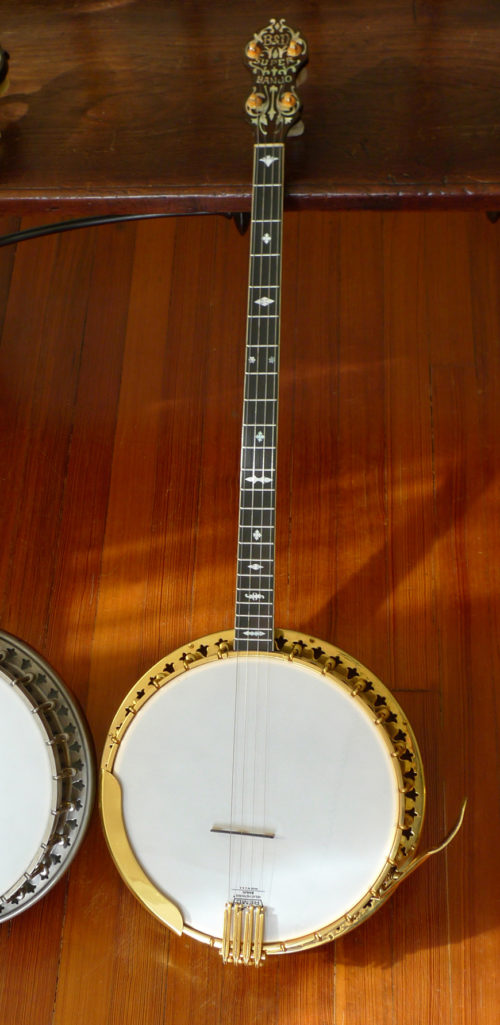 This rare 1926 example of Bacon & Day’s Super, Plectrum banjo is in wonderful condition– collectors quality, but it plays wonderfully. And this is the rare “Super” model A, gold plated. (All original, and with matching serial number on rim and dowel stick.) Original soft pedal stamped "Pat. Pend. B.&D. Soft Pedal." The original gold plating is in great condition, showing extremely little tarnishing, and no thin spots. In fact the banjo shows very little playwear at all. Original plectrum neck, original armrest– in fact all parts are original. Produced in the golden age of Bacon & Day (B&D) production, this banjo was made in Groton, CT. Although the earliest Bacon banjos were produced by various makers for Bacon from 1906-1920, the company’s best era began in 1922 when David Day left the Vega company to partner with Fred Bacon who had begun crafting his instruments in-house in 1920. The B&D banjos produced in this era are of considerably higher quality and are the sought after models by both players and collectors. The photos tell the story. 26 inch scale length. 22 fret plectrum 11″ rim In a recent hard shell case. ... no longer available ...
This rare 1926 example of Bacon & Day’s Super, Plectrum banjo is in wonderful condition– collectors quality, but it plays wonderfully. And this is the rare “Super” model A, gold plated. (All original, and with matching serial number on rim and dowel stick.) Original soft pedal stamped "Pat. Pend. B.&D. Soft Pedal." The original gold plating is in great condition, showing extremely little tarnishing, and no thin spots. In fact the banjo shows very little playwear at all. Original plectrum neck, original armrest– in fact all parts are original. Produced in the golden age of Bacon & Day (B&D) production, this banjo was made in Groton, CT. Although the earliest Bacon banjos were produced by various makers for Bacon from 1906-1920, the company’s best era began in 1922 when David Day left the Vega company to partner with Fred Bacon who had begun crafting his instruments in-house in 1920. The B&D banjos produced in this era are of considerably higher quality and are the sought after models by both players and collectors. The photos tell the story. 26 inch scale length. 22 fret plectrum 11″ rim In a recent hard shell case. ... no longer available ... -
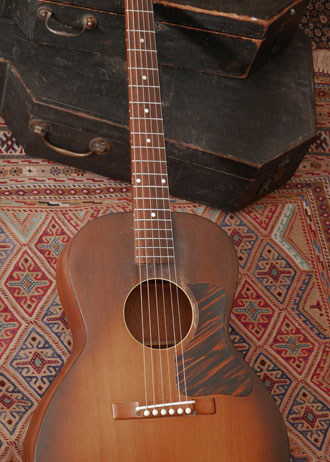 Read the full description below. If you're interested in this guitar, please call 512.922.8596 or contact us here.
Read the full description below. If you're interested in this guitar, please call 512.922.8596 or contact us here. -
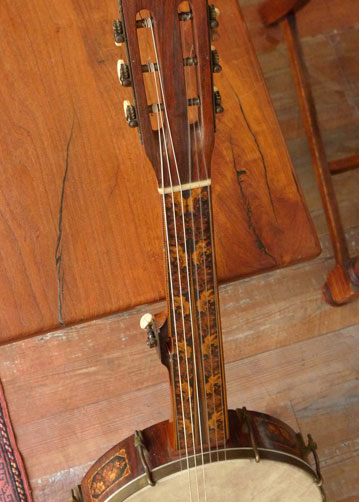 Read the full description below. If you're interested in this guitar, please call 512.922.8596 or contact us here.
Read the full description below. If you're interested in this guitar, please call 512.922.8596 or contact us here. -
Out of stock
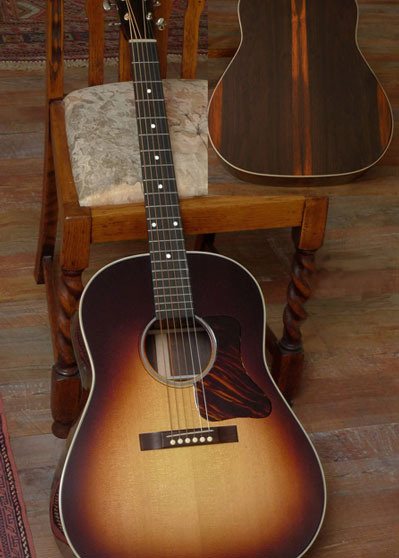 Another masterpiece from Charlottesville, Virginia-based Rockbridge Guitars. The slope shouldered dreadnought is faithful to the great Gibson J-35 of the late 1930’s, plus more: old-growth Brazilian Rosewood, with remarkable landscaping. Big big tone, volume, projection. Great sustain, ringing trebles, and yes most importantly string separation. Ebony fretboard. In a custom Cedar Creek case. Read the full description below. If you're interested in this guitar, please call 512.922.8596 or contact us here. ... no longer available ...
Another masterpiece from Charlottesville, Virginia-based Rockbridge Guitars. The slope shouldered dreadnought is faithful to the great Gibson J-35 of the late 1930’s, plus more: old-growth Brazilian Rosewood, with remarkable landscaping. Big big tone, volume, projection. Great sustain, ringing trebles, and yes most importantly string separation. Ebony fretboard. In a custom Cedar Creek case. Read the full description below. If you're interested in this guitar, please call 512.922.8596 or contact us here. ... no longer available ... -
Out of stock
 This guitar is a masterfully crafted interpretation of the fabled Roy Smeck, a slope-shouldered Gibson acoustic from the 1930s, which pairs a 12-fret neck with a standard, slope shouldered body, in Brazilian rosewood. From Charlottesville, Virginia-based Rockbridge -- one of the country’s most intriguing and masterful boutique luthiers. In a custom Cedar Creek case. Read the full description below. If you're interested in this guitar, please call 512.922.8596 or contact us here.
This guitar is a masterfully crafted interpretation of the fabled Roy Smeck, a slope-shouldered Gibson acoustic from the 1930s, which pairs a 12-fret neck with a standard, slope shouldered body, in Brazilian rosewood. From Charlottesville, Virginia-based Rockbridge -- one of the country’s most intriguing and masterful boutique luthiers. In a custom Cedar Creek case. Read the full description below. If you're interested in this guitar, please call 512.922.8596 or contact us here. -
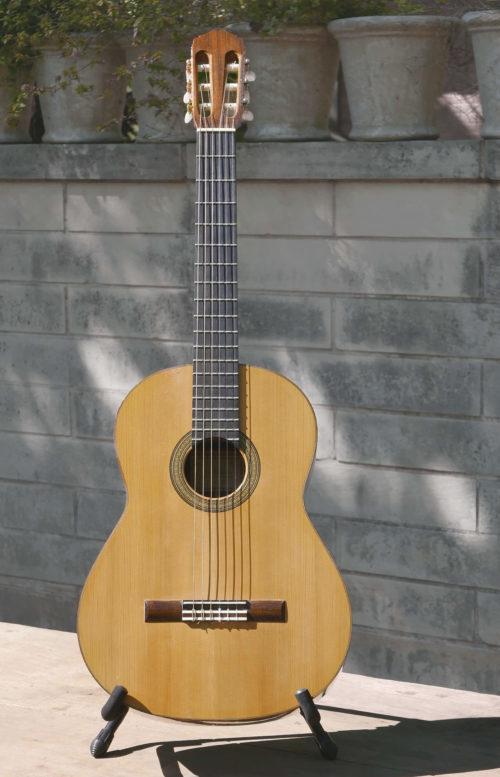 Tom Blackshear is a living legend in the classical and flamenco guitar worlds. He’s been building from his shop in Texas for decades, with an international client base and international prestige, and his older guitars especially are hard to find and in great demand (and rarely come to market. (There is currently one at Dream Guitars. This guitar was built in 1987, and was based on Jeffrey Elliott’s “1943 Hauser” plan. The tone is robust, and clear, with bright brazilian trebles, and the kind of nice string separation and clarity that an old German spruce top gives. The instrument:
Tom Blackshear is a living legend in the classical and flamenco guitar worlds. He’s been building from his shop in Texas for decades, with an international client base and international prestige, and his older guitars especially are hard to find and in great demand (and rarely come to market. (There is currently one at Dream Guitars. This guitar was built in 1987, and was based on Jeffrey Elliott’s “1943 Hauser” plan. The tone is robust, and clear, with bright brazilian trebles, and the kind of nice string separation and clarity that an old German spruce top gives. The instrument:- Tom Blackshear classical guitar, serial # 184, built in 1987; signed on label by the builder; also signed in pencil, on underside of top
- model: based on Jeffrey Elliott’s “1943 Hauser” plan
- Brazilian Rosewood back and sides
- German spruce top
- Brazilian Rosewood bridge
- Ebony fretboard
- Scale length: 660
-
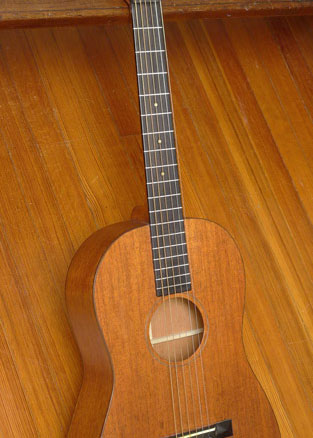 This is a very well made, custom Hawaiian guitar. Made by George Bailey, and signed and dated underside of top, 2009. The body style is similar to an early Ditson. In other regards, its size, sound, and feel is quite similar to a 1930’s Martin 0-17H.
This is a very well made, custom Hawaiian guitar. Made by George Bailey, and signed and dated underside of top, 2009. The body style is similar to an early Ditson. In other regards, its size, sound, and feel is quite similar to a 1930’s Martin 0-17H.- Mahogany back, sides, and top
- Mahogany neck
- Ebony fretboard
- Ebony bridge
- Flush frets, with raised nut and saddle, for Hawaiian playing
- Ladder braced
- Lower Bout width: 13 ¼ inches
- Scale length: 25 inches
- 1 ¾ inch nut
- Crack-free
-
Out of stock
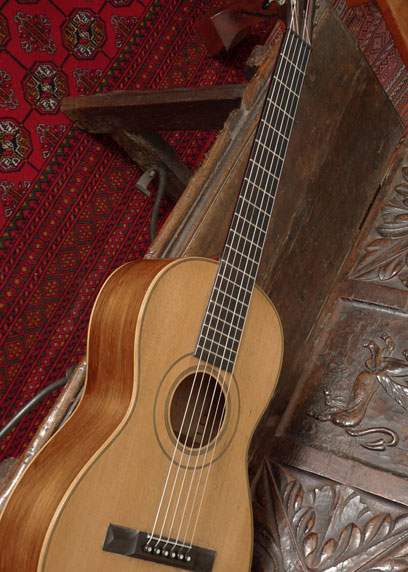 Circa 1860 guitar, style 3 built by well known luthier James Ashborn of Wolcottville, CT, for William Hall & Son music store. Brazilian rosewood back and sides; Adirondack top; maple binding. Rare Brazilian rosewood veneered neck. 100% original, including all original finish, and down to original nut, original bridge (and saddle) that has never been off the guitar. From an article in Vintage Guitar magazine: "Ashborn's design for the guitar was quite innovative for the early 19th century. Instead of making guitars fashioned after the typical parlor-style guitars, he made them in the Spanish style, by taking interior bracing cues from the Spanish while retaining the body of the English guitars. This included a fan brace pattern rather than the more common ladder pattern Ashborn guitars have a very complex dovetail V joint for attaching the head to the neck. The headstock was cut in roughly five steps, using some kind of tracing router, as suggested by the chatter marks on the inside ears of the pegbox. In addition to the complex head design, Ashborn made his own tuning machines in-house. They're made of brass, very much like contemporary machines, with worm gears, cog gears, and rollers. … Ashborn's shop was extremely advanced for its time, having a great deal of know-how and technology. Ashborn understood the need to have the technology as well as the skill, but more importantly he discovered a new way of making high-quality instruments that were affordable. He was able to create a factory environment where workers did what they were good at and, with practice, became very fast and consistent. With a new level of consistency in mass production, he created the path followed by other companies such as Martin, Gibson, and Taylor. Using designs ahead of his time, he was able to bring the sound and change to people who otherwise never would have been able to acquire an instrument of this quality."
Circa 1860 guitar, style 3 built by well known luthier James Ashborn of Wolcottville, CT, for William Hall & Son music store. Brazilian rosewood back and sides; Adirondack top; maple binding. Rare Brazilian rosewood veneered neck. 100% original, including all original finish, and down to original nut, original bridge (and saddle) that has never been off the guitar. From an article in Vintage Guitar magazine: "Ashborn's design for the guitar was quite innovative for the early 19th century. Instead of making guitars fashioned after the typical parlor-style guitars, he made them in the Spanish style, by taking interior bracing cues from the Spanish while retaining the body of the English guitars. This included a fan brace pattern rather than the more common ladder pattern Ashborn guitars have a very complex dovetail V joint for attaching the head to the neck. The headstock was cut in roughly five steps, using some kind of tracing router, as suggested by the chatter marks on the inside ears of the pegbox. In addition to the complex head design, Ashborn made his own tuning machines in-house. They're made of brass, very much like contemporary machines, with worm gears, cog gears, and rollers. … Ashborn's shop was extremely advanced for its time, having a great deal of know-how and technology. Ashborn understood the need to have the technology as well as the skill, but more importantly he discovered a new way of making high-quality instruments that were affordable. He was able to create a factory environment where workers did what they were good at and, with practice, became very fast and consistent. With a new level of consistency in mass production, he created the path followed by other companies such as Martin, Gibson, and Taylor. Using designs ahead of his time, he was able to bring the sound and change to people who otherwise never would have been able to acquire an instrument of this quality." -
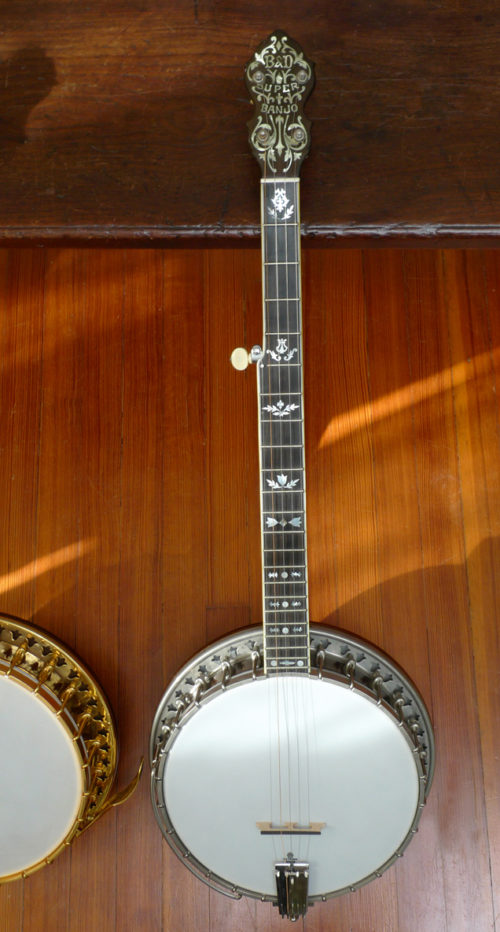 This is a superb sounding 5 string banjo. Quoting George Gruhn in “The Vintage Catalogue”– “During the banjo boom of the 1920s, many musicians considered Bacon & Day to be the finest banjo maker of the time. Their instruments were prized for their exceptional volume and cutting power, as well as for their beautiful craftsmanship… we can only speculate what might have happened if Earl Scruggs, Don Reno, or some other well-known bluegrass player had used a Bacon & Day model.” • Bacon & Day Super, 5-string Banjo (Style A) Serial number: 25892 (early 1928) • Resonator, stamped on inside (in nickel-laminated maple): Bacon Banjo Co., Inc. Groton, CT. U.S.A. Dec. 20th, 1927 • Conversion, 5 string neck (original neck was probably a tenor or plectrum); Presumably, this neck is newer than the banjo– yet the advanced MOP fret markers are as found on the earliest versions of B&D Super banjos. We assume this neck was built by one of the very best U.S. “conversion” builders – with a re-use of the original MOP inlay at the peghead plus the dowel stick. Maple neck, with steel reinforcing rod. Fretboard is beautiful jet-black ebony; multi-layer neck bindings. • 22 frets • Scale length: 27 inches • Extended Maple resonator– nickel laminated on inside • Original flat Tulip-hole flange (not the “add-on” round-hole resonator of earlier years). • Original, top of the line Type III Silver Bell tone ring (No Hole tone ring) original to the instrument (this is the most sought-after, advanced tone ring, introduced early 1927). • Original 2 band Grover geared tuning pegs • Fults tailpiece, and included a variety of Fults tone pins. Bob Fults made the best tailpieces available. And his tone pins let you tweak the tone of your banjo. There are several interchangeable Fults pins included here– ivory, ebony, lead, sterling silver, brass, and copper. Plus a "tone lock". (Bob Fults recently retired, and these highly sought after Fults tailpieces and pins are no longer available.) In its original hard shell case. Price: $3950.
This is a superb sounding 5 string banjo. Quoting George Gruhn in “The Vintage Catalogue”– “During the banjo boom of the 1920s, many musicians considered Bacon & Day to be the finest banjo maker of the time. Their instruments were prized for their exceptional volume and cutting power, as well as for their beautiful craftsmanship… we can only speculate what might have happened if Earl Scruggs, Don Reno, or some other well-known bluegrass player had used a Bacon & Day model.” • Bacon & Day Super, 5-string Banjo (Style A) Serial number: 25892 (early 1928) • Resonator, stamped on inside (in nickel-laminated maple): Bacon Banjo Co., Inc. Groton, CT. U.S.A. Dec. 20th, 1927 • Conversion, 5 string neck (original neck was probably a tenor or plectrum); Presumably, this neck is newer than the banjo– yet the advanced MOP fret markers are as found on the earliest versions of B&D Super banjos. We assume this neck was built by one of the very best U.S. “conversion” builders – with a re-use of the original MOP inlay at the peghead plus the dowel stick. Maple neck, with steel reinforcing rod. Fretboard is beautiful jet-black ebony; multi-layer neck bindings. • 22 frets • Scale length: 27 inches • Extended Maple resonator– nickel laminated on inside • Original flat Tulip-hole flange (not the “add-on” round-hole resonator of earlier years). • Original, top of the line Type III Silver Bell tone ring (No Hole tone ring) original to the instrument (this is the most sought-after, advanced tone ring, introduced early 1927). • Original 2 band Grover geared tuning pegs • Fults tailpiece, and included a variety of Fults tone pins. Bob Fults made the best tailpieces available. And his tone pins let you tweak the tone of your banjo. There are several interchangeable Fults pins included here– ivory, ebony, lead, sterling silver, brass, and copper. Plus a "tone lock". (Bob Fults recently retired, and these highly sought after Fults tailpieces and pins are no longer available.) In its original hard shell case. Price: $3950.